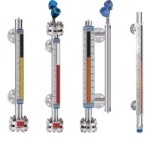 |
Industrial Magnetic Flow Meter
Courtesy Yokogawa Corp.
|
Flow measurement is a ubiquitous function in the industrial process control field. Anywhere there are pipes, somebody wants to know what, and how much, is passing through them. Fortunately for us engineers, there is a wide array of
industrial flow meters capable of measuring some physical characteristic of fluid moving within a pipe that can be translated into a useful measurement of flow rate.
In industry, there are a number of different technologies used to measure a physical property related to fluid motion, referred to as magnetic, ultrasonic, vortex, Coriolis, differential pressure, and several others. Each methodology exists in the market because it may perform better or cost less when meeting certain performance requirements. This article is focused on magnetic flow meters and when they may be a good candidate for your project.
Here is a list of some of the positive attributes of magnetic flow meters.
- Magnetic flow meters have no moving parts, always a plus.
- General construction arrangement allows for use of an interior liner for corrosion resistance.
- With no sensor insertions into the fluid flow, the impact of the instrument on the flow is minimized.
- Accuracy, when compared to other technologies, is high.
- Application to laminar, turbulent, and transitional flow profiles is permissible.
- General insensitivity to fluid viscosity, specific gravity, temperature and pressure.
- Magnetic flow meter technology can be applied to a very wide range of pipe sizes.
- Device responds rapidly to changes in fluid flow.
- Can be successfully applied to liquids containing heavy particulates.
- Generally long service life with little maintenance.
There are, though, some points about magnetic flow meters which may make them unsuitable for your application.
- Magnetic flow meters only work on liquids with conductivity above a certain threshold. They may be unsuitable for use with hydrocarbons and high purity water for this reason.
- Cannot be used to measure gas flow.
- Pipe must be grounded.
- Typically, the pipe cross section must be filled by the fluid being measured.
This listing of positives and negatives is intended to be very general in nature. Some manufacturers may have product application solutions that overcome some of the negatives, while others may not be able to deliver all of the positives.
Your best course of action:
Use this general overview to start shaping you understanding of where magnetic flow meters may be a good option, and contact a
product application specialist to discuss what you want to accomplish. Combining your process knowledge with their product knowledge should move you toward a good solution.





